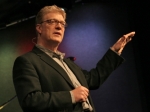If students are not learning, education is not happening.
The root task is to create the conditions in which the relationship between students and teachers can flourish.
Sir Ken Robinson, Creative Schools
———————
It is no secret – we are all worried about the quality of education. I suspect that we expect the practically impossible. We have to prepare our students for a life that is not yet in full focus. Who knows – literally, who knows – what the job demands and possibilities will be in coming years?
But, we keep asking “how do we improve our schools?,” as we should. And at the forefront of that asking is Sir Ken Robinson.
I presented my synopsis of his latest book, Creative Schools: The Grassroots Revolution that’s Transforming Education at this month’s Urban Engagement Book Club, sponsored by CitySquare.
I began my synopsis with this question: Why is this book worth our time?
#1 – The “old” models for school and education are no longer working. The new is being born/discovered. This book describes the possibilities.
#2 – Education matters to each person, and each community. It is the job of all of us to help make education better.
#3 – And, since it is the job of each/all of us, we have to help raise up the solutions “from the grassroots.”
Mr. Robinson especially believes that we need the “grassroots,” to drive creativity and innovation in schools. In other words, not a “top down” but a “bottom and middle up” approach. The teachers get a voice – the biggest voice! From the book:
While education systems around the world are being reformed, many of these reforms are being driven by political and commercial interests that misunderstand how real people learn and how great schools actually work.
And, he is a not a big fan of standardization and conformity:
If you run an education system based on standardization and conformity that suppresses individuality, imagination, and creativity, don’t be surprised if that’s what it does.
The old systems of education were not designed with this world in mind. Improving them by raising conventional standards will not meet the challenges we now face.
The standards movement is not achieving the objectives it has set for itself. Meanwhile, it is having catastrophic consequences on student engagement and teacher morale.
The problem with conformity in education is that people are not standardized to begin with.
Here is my “summary in a box” of this book:
Things in education need to change. The change needs to be toward the needs of the individual student. To get there, we’re going to have to dramatically change the assessment approach. Our students, and our economies, need such change to occur. It’s time to get creative!

And, an important reminder: in case you do not know who Ken Robinson is, he has the most viewed TED Talk ever: Do Schools Kill Creativity? (By the way, he is quite funny; an entertaining speaker — and writer).
In this book, he tells plenty of great stories, with special emphasis on the 5th grade “Shakespeare class” led by Rafe Esquith – Hobart’s Shakespeareans’ Performances in Room 56 at Hobart Boulevard Elementary in Los Angeles. Though Rafe Esquith has his own web site, Ken Robinson’s story-telling ability makes this section of the book worth reading!
Here are a few of the points I made from the book in my synopsis:
- This is the problem:
- the education system now in disarray was designed for a different time, with different needs in society for an “educated person” – i.e., the Industrial Revolution needs…
- Today’s “educated person” has to have a different knowledge base, different skills and capabilities…
- “Teaching” is not as effective as “facilitating learning”
- The core role of a teacher is to facilitate learning.
- He includes a terrific summary of the change process:
- to transform any situation you need three forms of understanding: a critique of the way things are, a vision of how they should be, and a theory of change for how to move from one to the other.
And here is my summary of his Solutions, with my six Lessons and takeaways
#1 – View and Treat students as individuals. — It’s time to let the “personalize everything” movement move to education.
#2 – Invest (heavily) in the training and development of teachers
#3 – Raise up many, many more great principals
#4 – Communicate with/work with parents, starting where they are!
#5 – It’s all about the teacher and/with the student. — The fundamental purpose of education is to help students learn. Doing that is the role of the teacher. But modern education systems are cluttered with every sort of distraction.
#6 – Greatly reduce the number of standardized tests!
Sir Ken Robinson is one of the most consistent and creative voices we have regarding the current challenges we face in education. I highly recommend reading this book!
 URBAN ENGAGEMENT BOOK CLUB
URBAN ENGAGEMENT BOOK CLUB
What kind of book club is the Urban Engagement Book Club? A different kind of book club! You don’t have to read the book–Randy Mayeux will present the key content of the selected book each month, with a comprehensive handout of key quotes and key ideas from the book. Then, in conversation with a diverse group of fellow participants, we discuss the implications of the book out of our shared concern for social justice. It is a wonderful, challenging session that always puts us back in touch with the struggles of real people in an increasingly difficult time.
Come join us, noon, the third Thursday of each month. Click here for the upcoming books, and all the details.
